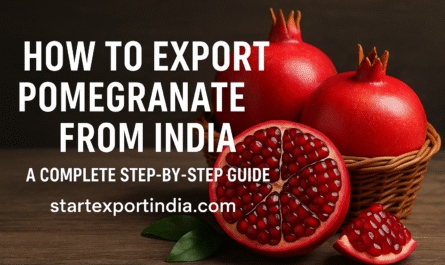- Introduction to Green Millet/Bajra Export
- What is Green Millet/Bajra?
- Global Demand for Bajra and Key Importing Countries
- Understanding India’s Role in Bajra Exports
- Key Benefits of Exporting Bajra from India
- Legal Requirements for Bajra Export from India
- Export Documentation Required for Bajra
- Selecting the Right Bajra Variety for Export
- Bajra Processing & Packaging Guidelines
- Finding International Buyers for Bajra
- Bajra Export Pricing & Costing Strategy
- Shipping and Logistics for Bajra Export
- Challenges in Bajra Export and How to Overcome Them
- Government Schemes & Incentives for Bajra Exporters
- Future Opportunities in Bajra Export
- FAQs on Exporting Bajra from India
- Conclusion
Introduction to Green Millet/Bajra Export
If you’re wondering how to export Bajra from India, you’re stepping into one of the most promising agri-business sectors today. Green Millet, also known as Pearl Millet or Bajra, is increasingly valued in the global market for its high nutritional value and gluten-free properties. With rising global demand for healthy grains, the Bajra export process from India offers lucrative opportunities for new and experienced exporters alike.
What is Green Millet/Bajra?
Green Millet, or Bajra, is a small-seeded cereal crop rich in protein, fiber, and minerals. The Bajra export requirements often depend on the importing country’s quality standards, including grain size, purity, and moisture content requirements. It’s primarily used in making rotis, porridges, and health-based products for gluten-free diets.
Global Demand for Bajra and Key Importing Countries
The Bajra export markets are expanding rapidly, with demand surging in:
- UAE – strong demand from Indian diaspora
- Saudi Arabia – traditional food preparation
- USA & Canada – gluten-free and organic food industry
- Europe – vegan and organic products sector
- African nations – as a staple and relief food
Understanding India’s Role in Bajra Exports
Major Millet-Producing States in India
India dominates the millet export market, with key states including Rajasthan, Uttar Pradesh, Haryana, Gujarat, and Maharashtra producing the bulk of the crop.
Export Trends and Statistics
According to APEDA, the Bajra export process from India has grown 15–20% annually, especially for organic and premium-grade millet varieties.
Key Benefits of Exporting Bajra from India
The Bajra export opportunities are driven by:
- Global awareness of healthy grains
- Competitive pricing from India
- Abundant production capacity
- Diverse Bajra import export business models
Legal Requirements for Bajra Export from India
Registration with DGFT
All exporters must register with DGFT to start the Bajra export process.
Getting an Import Export Code (IEC)
Mandatory for any exporter; required for Bajra export license India.
FSSAI and APEDA Registration
APEDA registration is essential for agricultural exports, including APEDA registration for Bajra export.
Compliance with International Standards
Ensure compliance with Bajra export quality standards, such as ISO, HACCP, and organic certifications.
Export Documentation Required for Bajra
For smooth Bajra export documentation, prepare:
- Commercial Invoice & Packing List
- Bill of Lading or Airway Bill
- Phytosanitary & Quality Certificates
Selecting the Right Bajra Variety for Export
Choosing the right grain is key to meeting Bajra export quality standards. Select varieties with low moisture content and uniform grain size to meet Bajra moisture content requirements.
Bajra Processing & Packaging Guidelines
Cleaning, Grading, and Sorting
Modern machinery ensures Bajra export packaging meets cleanliness and uniformity standards.
Packaging Materials and Labeling
Common packaging includes 25kg or 50kg PP woven or jute bags. Label with country of origin, net weight, and certification details.
Finding International Buyers for Bajra
Finding buyers is crucial for a successful Bajra export buyers list.
- Join B2B platforms like Alibaba, Indiamart, and TradeIndia.
- Attend trade fairs like Gulfood and SIAL.
- Use APEDA’s verified buyer directory.
Bajra Export Pricing & Costing Strategy
Pricing is determined by Bajra export price per ton, factoring in production, packaging, freight, and customs.
Shipping and Logistics for Bajra Export
Understanding Bajra shipping and logistics is essential:
- Sea freight for large volumes (economical)
- Air freight for smaller, urgent shipments
Challenges in Bajra Export and How to Overcome Them
Key Bajra export challenges include meeting international standards and managing price fluctuations. Solutions include quality control systems and forward contracts.
Government Schemes & Incentives for Bajra Exporters
Government programs support Bajra export incentives, including Bajra export APEDA subsidy and duty drawback schemes.
Future Opportunities in Bajra Export
The future is bright for Bajra export business opportunities, especially in organic and value-added millet products.
FAQs on Exporting Bajra from India
Q1. How to export Bajra from India?
You need an IEC code, APEDA registration, and compliance with Bajra export requirements.
Q2. Which countries import Bajra from India?
UAE, Saudi Arabia, USA, and African nations.
Q3. What’s the ideal Bajra moisture content requirement?
Below 12%.
Q4. Do I need certification for organic Bajra export?
Yes, for all organic claims.
Q5. What’s the typical Bajra export price per ton?
Varies based on quality and market conditions.
Conclusion
By following this Bajra export process from India, you can successfully enter the growing global millet market. Focus on quality, documentation, and building a strong buyer network to thrive in the Bajra export markets. For professional help, visit Start Export India.



